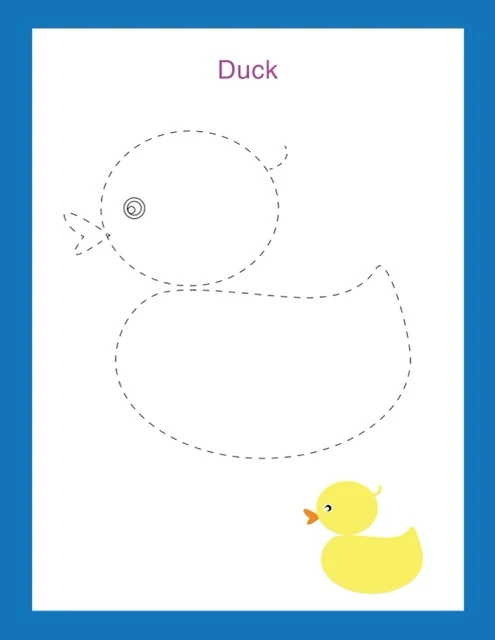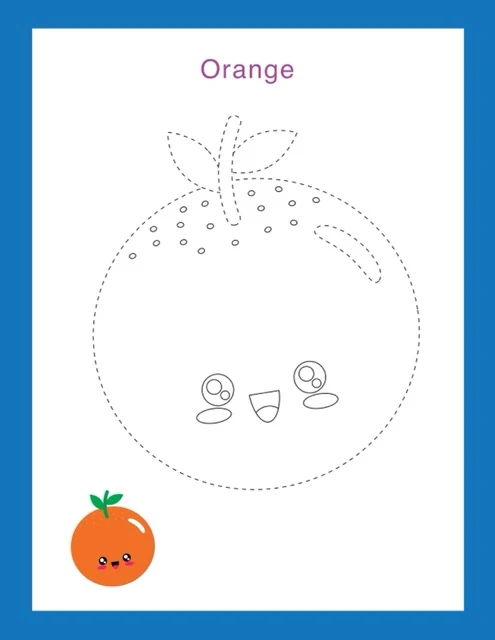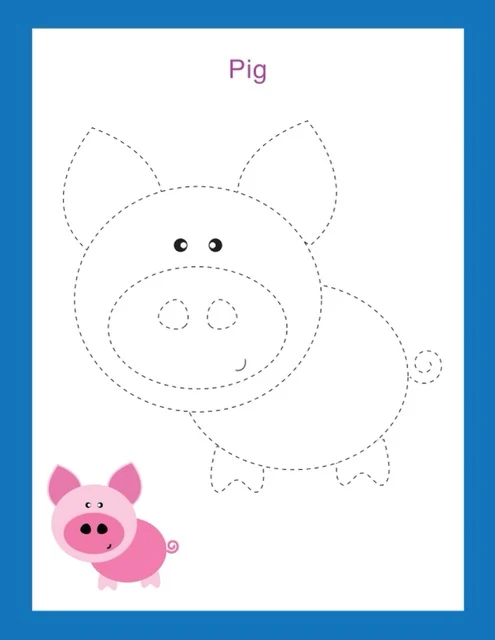Tracing Activities: Fostering Early Development
Tracing activities for young children are presented as a foundational element in early childhood development. These activities significantly contribute to fine motor skill development, hand-eye coordination, and pre-writing skills, ultimately aiding writing proficiency. Beyond motor skills, tracing fosters cognitive benefits like improved focus and problem-solving, and emotional benefits such as increased confidence. The sources emphasize the accessibility and adaptability of tracing activities for diverse learners and suggest engaging strategies to make the process enjoyable and effective. Starting with simple exercises and using various materials are highlighted as key elements for success.
Tracing Activities for Young Children
Briefing Document: Tracing Activities for Young Children
Main Themes:
●
Tracing as a foundational activity: This document collection emphasizes the importance of tracing activities for developing fine motor skills, hand-eye coordination, and pre-writing skills in young children. Tracing is presented as a key stepping stone towards mastering writing and other essential skills.
●
Benefits beyond motor skills: The sources highlight that tracing offers a wide range of benefits beyond motor skill development. These include:
○
Cognitive development: Improved concentration, focus, problem-solving, and creativity.
○
Emotional development: Increased confidence and a sense of accomplishment.
●
Accessibility and Adaptability: Tracing activities are presented as accessible to children of all abilities and easily adaptable to different learning styles and needs. Emphasis is placed on the use of various materials, engaging activities, and starting with simple exercises before progressing to more complex ones.
Key Ideas & Facts:
●
Definition of Tracing: "Tracing is the act of following a pre-existing line or pattern with a pencil, crayon, or other writing instrument." - Tracing Activities: A Guide for Parents
●
Developmental Benefits: "Tracing helps children develop the small muscles in their hands and fingers, essential for controlling a writing instrument... Tracing requires precise visual tracking and hand movement, improving the coordination between eyes and hands." - Tracing Activities: A Guide for Parents
●
Variety of Activities: Tracing encompasses a wide range of activities, from simple lines and patterns to complex shapes, letters, numbers, and even outlines of objects and pictures.
●
Engaging Children: Tips for engaging children include:
○
Starting with simple exercises and gradually increasing complexity.
○
Using colorful materials and turning tracing into a game.
○
Providing positive reinforcement and praising efforts.
○
Incorporating tracing into everyday activities like mealtimes or playtime.
●
Materials: A variety of materials can be used, including pencils, crayons, markers, and finger paints, each offering a different sensory experience.
●
Starting Age: Children can start tracing as early as two years old.
●
Benefits for Children with Special Needs: Tracing can be particularly beneficial for children with special needs, offering a calming and repetitive activity that helps them focus and improve motor skills.
Quotes from Sources:
●
"The primary purpose of tracing activities is to develop fine motor skills, hand-eye coordination, and pre-writing skills in young children." - Tracing Activities: A Study Guide
●
"Starting simple allows children to build confidence and gradually develop their skills without feeling overwhelmed or frustrated." - Tracing Activities: A Study Guide
●
"Tracing can be especially beneficial for children with special needs by providing calming repetitive activity, helping them focus, and improving motor skills and coordination through visual and tactile feedback." - Tracing Activities: A Study Guide
Conclusion:
The provided sources offer a comprehensive overview of tracing activities, highlighting their importance in early childhood development. Tracing is not just about learning to write; it plays a crucial role in developing a wide range of skills, fostering confidence, and providing an accessible and enjoyable learning experience for young children.
Tracing Activities: A Guide for Parents
Tracing Activities: An FAQ
What is tracing?
Tracing is the act of following a pre-existing line or pattern with a pencil, crayon, or other writing instrument. It's a valuable activity for developing fine motor skills, hand-eye coordination, and pre-writing skills in young children.
What are the benefits of tracing activities for children?
Tracing activities offer a wide array of benefits for children's development, including:
●
Improved fine motor skills: Tracing helps children develop the small muscles in their hands and fingers, essential for controlling a writing instrument.
●
Enhanced hand-eye coordination: Tracing requires precise visual tracking and hand movement, improving the coordination between eyes and hands.
●
Preparation for writing: Tracing familiarizes children with the shapes and movements involved in forming letters and numbers, laying the foundation for writing.
●
Increased concentration and focus: Tracing requires sustained attention, promoting concentration and focus.
●
Boosted confidence: Successfully tracing lines and shapes provides a sense of accomplishment and boosts confidence in their abilities.
What types of tracing activities are available?
Tracing activities can encompass various designs, catering to different skill levels and interests:
●
Simple Lines and Patterns: Beginners can start by tracing straight lines, curved lines, zigzags, and other basic patterns.
●
Shapes: Tracing basic shapes like circles, squares, triangles, and stars helps children recognize and reproduce these fundamental forms.
●
Letters and Numbers: Tracing letters and numbers introduces children to the building blocks of writing and reinforces their recognition.
●
Pictures and Objects: Tracing outlines of objects, animals, or everyday items adds an element of fun and encourages creativity.
What are some tips for engaging children in tracing activities?
●
Start simple: Begin with large, easy-to-trace lines and shapes. Gradually increase the complexity as the child's skills develop.
●
Make it fun: Use colorful crayons or markers, themed tracing sheets, or turn it into a game.
●
Provide positive reinforcement: Encourage and praise the child's efforts and progress, fostering their motivation and confidence.
●
Be patient: Tracing takes practice and patience. Allow the child to learn at their own pace without pressure.
How can I incorporate tracing into everyday activities?
Tracing can be seamlessly integrated into daily life:
●
During meals: Let your child trace the outlines of their plate, cup, or cutlery with their finger.
●
While playing: Use playdough or finger paints to trace shapes or letters on a table or tray.
●
Outdoors: Encourage your child to trace shapes in the sand or draw with chalk on the sidewalk.
What are the best materials for tracing activities?
A variety of materials can be used for tracing, each offering a different sensory experience:
●
Pencils: Pencils provide good control and precision, ideal for developing handwriting skills.
●
Crayons: Crayons are colorful and easy to grip, making tracing enjoyable for young children.
●
Markers: Markers produce bold lines, adding visual appeal to traced designs.
●
Finger paints: Finger paints provide a tactile and sensory-rich experience while tracing.
At what age can children start tracing?
Children can begin engaging in tracing activities as early as 2 years old. Starting with simple lines and shapes, you can gradually introduce more complex patterns as their development progresses.
How can tracing benefit children with special needs?
Tracing activities can be particularly beneficial for children with special needs, such as those with autism or developmental delays. The repetitive nature of tracing can be calming and help them focus, while the visual and tactile feedback improves motor skills and coordination.
Tracing Activities: A Study Guide
Tracing Activities: A Study Guide
Short-Answer Questions
1.
What is the primary purpose of tracing activities for young children?
2.
List three benefits of tracing activities for children's development.
3.
Describe two different types of tracing activities suitable for beginners.
4.
Explain two strategies for engaging children in tracing activities and keeping them motivated.
5.
Provide an example of how tracing can be incorporated into everyday activities.
6.
Explain the importance of starting with simple tracing exercises and progressively increasing complexity.
7.
Which tracing material offers a sensory-rich experience and what are its benefits?
8.
What is the suggested starting age for introducing tracing activities to children?
9.
Describe how tracing can be beneficial for children with special needs.
10.
Besides pencils and crayons, suggest two alternative materials for tracing.
Short-Answer Key
1.
The primary purpose of tracing activities is to develop fine motor skills, hand-eye coordination, and pre-writing skills in young children.
2.
Three benefits of tracing are: improved fine motor skills, enhanced hand-eye coordination, and preparation for writing. (Other valid answers: increased concentration, boosted confidence).
3.
Two types of tracing activities for beginners are tracing simple lines and patterns (straight lines, curves, zigzags), and tracing basic shapes (circles, squares, triangles).
4.
Two strategies for engaging children are: using colorful materials and themed sheets to make it fun, and providing positive reinforcement and praise to foster motivation.
5.
During meals, children can trace the outlines of their plate, cup, or cutlery with their finger, incorporating tracing into an everyday activity. (Other valid examples: tracing shapes in sand, drawing with chalk on the sidewalk).
6.
Starting simple allows children to build confidence and gradually develop their skills without feeling overwhelmed or frustrated. As they master basic shapes and patterns, they can move on to more complex designs.
7.
Finger paints offer a tactile and sensory-rich tracing experience, engaging multiple senses and making it enjoyable for young children.
8.
Children can start tracing as early as 2 years old, beginning with simple lines and shapes.
9.
Tracing can be especially beneficial for children with special needs by providing calming repetitive activity, helping them focus, and improving motor skills and coordination through visual and tactile feedback.
10.
Two alternative materials for tracing besides pencils and crayons are markers and finger paints.
Essay Questions
1.
Discuss the connection between tracing activities and the development of pre-writing skills in young children.
2.
Analyze the role of sensory experience in tracing activities and how different materials can enhance the learning process.
3.
Explain how tracing activities can promote cognitive development beyond fine motor skills, addressing aspects like concentration, problem-solving, and creativity.
4.
Evaluate the importance of parental involvement and encouragement in fostering a positive and successful tracing experience for children.
5.
Design a comprehensive tracing program for a preschool classroom, outlining learning objectives, materials, activity progression, and assessment strategies.
Glossary of Key Terms
●
Fine Motor Skills: The ability to use small muscles in the hands and fingers for precise movements, such as writing, drawing, and buttoning.
●
Hand-Eye Coordination: The synchronized control of hand movements guided by visual input.
●
Pre-Writing Skills: The foundational skills necessary for writing, including hand strength, control, and understanding basic strokes and shapes.
●
Tracing: The act of following a pre-existing line or pattern with a writing instrument to reproduce the shape.
●
Sensory Experience: The engagement of different senses (touch, sight, sound) during an activity, enriching the learning process.
●
Cognitive Development: The process of acquiring knowledge, skills, and understanding through thought, experience, and the senses.
●
Positive Reinforcement: Encouraging desired behaviors through praise, rewards, or positive feedback to motivate and build confidence.
●
Developmental Delays: Slower than typical progress in acquiring certain skills or milestones.
●
Tactile: Related to the sense of touch.































